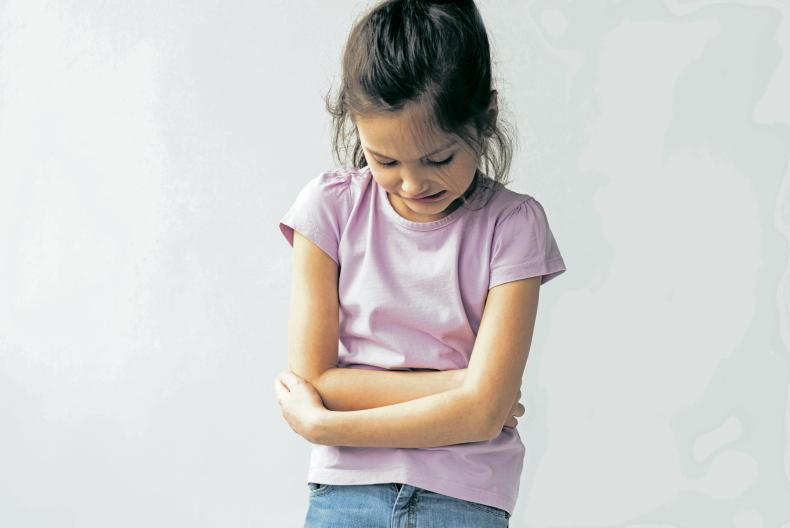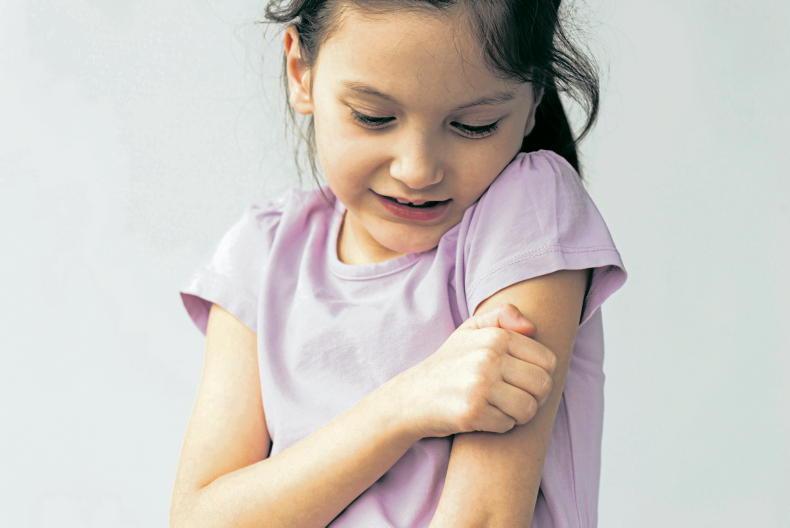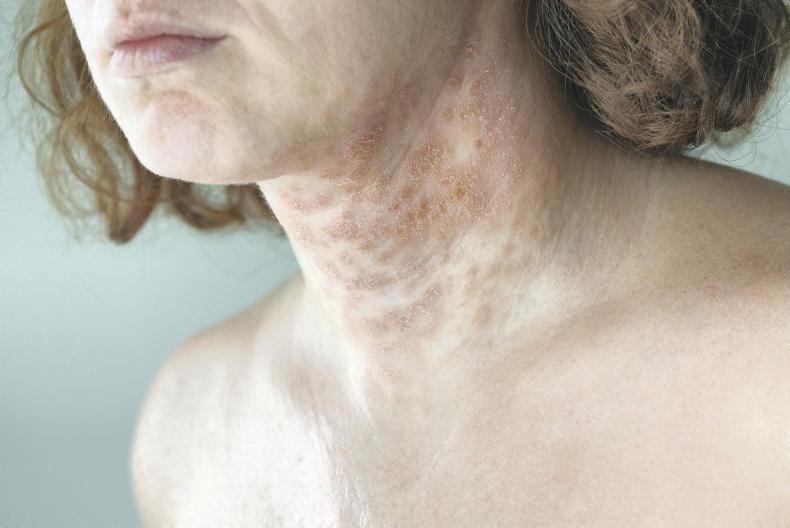As a pharmacist, Tom Murray is used to parents seeking help during summer with various children’s summer ailments.
Asked to give his top five of these, he lists hayfever, sunburn, prickly heat rash, bites and stings and tummy upsets as the major sport-spoilers in summer.
Luckily, there are practical tips and over-the-counter treatments for each that allow children to get back to full health as quickly as possible.
“About 20% of the population suffer from hayfever (seasonal rhinitis) so that’s one in five, adults and children,” he says.
“Symptoms can vary from mild to severe depending on the person’s sensitivity and they can be affected from mid to late April right through to the end of September.
Mid-summer is, of course, the peak time for grass and tree pollens and the time when people suffer the most, but there are some people who have hay fever for six months.”
The symptoms are runny nose, itchy eyes and a scratchy or tickly throat.
“It’s all based on a histamine release,” he says. “Histamine is an inflammatory mediator in the body and hay fever is an inappropriate release of histamine, which causes inflammatory symptoms. It can be serious but even if you have a child who has a constantly runny nose and itchy, swollen eyes it can be quite debilitating for them.”
He has some practical tips to help your child and some pharmaceutical ones.
- Your child should avoid pollen as much as possible i.e. avoid being out when grass is being cut e.g. lawns and silage.
- Get them to coat the inside of their nostrils with Vaseline. Pollen sticks to it and then isn’t inhaled.
- Wear wraparound sunglasses to stop pollen getting into the eyes.
- Don’t dry your children’s clothes outside if they suffer from hayfever as pollen can stick to clothes.
- Wash hands and hair, hands particularly, after being outside so that they don’t rub pollen into their nose, mouth or eyes. The pollen may be stuck to fingers.
Pharmaceutical products for hayfever
There are over-the-counter pharmaceutical remedies depending on the child’s age, he says, with antihistamines being number one.
“They [tablets or liquid] are taken once, sometimes twice, a day and will prevent most of the symptoms.
If the child is over 12 they can use a steroid nasal spray as well. If taken prior to the season steroid sprays can prevent all symptoms but they take a while to prevent inflammation.
If your sensitivity to pollen is severe, it’s best to take them [from] early [in April] and right through to the end of the season, that’s daily/twice a day, depending on the age of the child.”
Liquid antihistamines are generally used for children aged 2-10 years because they are easy to take, work quickly and don’t cause drowsiness.
“The pharmacist will always advise you on the safest and most appropriate medicine for your child. The important thing is to talk to us about the appropriate dose given the child’s age and weight.”
Some parents become expert very quickly, he adds.
“They get to know their child’s pattern and the treatment. Itchy eye drops from Optrex can help as well. They contain a medicine that is like an antihistamine for the eyes.”
He reiterates that you can’t use steroid nasal sprays on an “as required” or “ad hoc” basis. Instead they have to be used regularly at a very low level to work.
“They are very safe at that level. The steroid is only administered through the nasal passages. Again they are only for children over 12 years of age. Decongestant nasal sprays can be used as required but you can’t use them for long periods of time. Your pharmacist will advise.”
Sunburn is something that pharmacists are consulted about a lot.
“We see huge numbers of people turning up with sunburn, of all ages, often teenagers and people in their early 20s who are out partying and don’t realise how much they are getting burned,” he states.
“Other times it’s children, where sun lotion has been forgotten, or it’s been forgotten to reapply.”
There are key tips that can help prevent sunburn happening at all, however.
“Protection and avoidance is key,” he says. “There are effective sun protective clothes with sleeves that you can get for young children in most retail shops.”
Also:
- Have them wear hats with wide brims to cover the face and neck.
- Avoid strong sunlight as much as possible and
- Apply very strong sun protection lotion – factor 50 for a child is preferable, but at least factor 30, making sure that it has good UVA and UVB protection.
- Apply it 20 mins to half hour before you go out into the sun and apply regularly after. Even if the bottle says that it is waterproof, apply it again after swimming. It may be water resistant rather than waterproof.
Sunburn treatment
If you do get sunburned, treating it early is important.
“Don’t leave it for days until it has blistered,” he says. “Get pure aloe vera gel or lotion and apply it soon after. It is great for cooling skin and bringing down sunburn.
Calamine lotion is good too and there are after sun lotions also that can be used. Applying them early is key.”
He points out that sun protection lotion is available in handy pocket size packs now for bringing on days out when you want to travel light.
“Many people may not want to carry a bottle so they’re a good option for people to carry on days out. Reapplying is important as the day goes on.”
Lots of fluids
Making sure that your child, particularly 2-6 year olds, are well hydrated during summer is important too.
“Make sure, if out in sun, that they are drinking lots and lots of fluids because sunstroke and dehydration can happen very quickly.
The child can get very lethargic with a headache and sometimes feel dizzy. Ice cream is a good way of getting fluids on board because of its high water content.”
The third most common summer children’s ailment that pharmacists help to treat. Again it’s related to sun sensitivity.
“It is an itchy red pimply rash, an inflammatory reaction in the skin, on the site of exposure to the sun. It can be quite annoying, particularly for children.
As with sunburn you can use aloe vera or calamine lotion or other soothing creams and ointments available over the counter.
It’s about preventing exposure to strong sun, wearing tops that cover the arms, and using sun suits for children that go down to the wrists.”
Antihistamines can be used for prickly heat discomfort also, but he points out that these can increase skin sensitivity to the sun in some cases.
“Discuss it with your pharmacist before you decide which one you or your child should take. If you are experiencing a prickly heat rash you should avoid the sun for the next two to three days to allow it to resolve.”
Insect bites and stings are hugely common in summer, of course, with people spending more time outdoors in gardens, fields, parks and at beaches. Local treatment (on the bite or sting site) is better than generalised treatment for bites and stings, he says.
“There are antihistamine creams like Anthisan that are really effective if applied within 15 minutes of the bite or sting.
If you have large bites, you can use antihistamine tablets as well to bring down the inflammation. Antihistamine cream or liquid can be used after that also because a bite or sting is usually an allergic reaction.”
Be mindful of infection though, he adds.
“Some bites or stings can become infected. They will be very red and feel warm and quite painful.
If you show them to your pharmacist, he or she
will know whether to refer you on to a GP for antibiotics or whether they will respond to antihistamines.”
He suggests that, if a child has a bite, that parents draw a red pen circle around it.
“If it spreads beyond the pen then you know it could be infected and that you need further treatment.
Bring your child to a pharmacist and show them the bite. What usually happens after you take an antihistamine is that the bite tends to shrink. With infection it expands.”
Note: You can get bulls’ eye rashes and bites that involve ticks and lyme disease risk. Tick awareness is very important from April to October if you are spending time outdoors. You can find previous articles about lyme disease online at www.farmersjournal.ie

Gastrointestinal problems can be common in summer.
Gastrointestinal problems can be common in summer with children eating more junk food on holiday and barbecues sometimes an issue.
“We see tummy upsets in all age groups in summer,” Tom Murray says, “because sometimes we aren’t the best at barbecuing and we may not have prepared the food properly. Sometimes food has travelled in the car also and hasn’t been kept in a cool bag.”
The most important remedy for tummy bugs is rest and rehydration.
“For a young child aged 2-6 years who is vomiting and has diarrhoea, the most important thing is fluids. It should never be large glasses in one go as it won’t be absorbed or could be vomited back up. The key is constant sipping across the day and bland food as they rest and recover.”
There are electrolyte sachets available for children and adults that help with rehydration too, he adds.
“Teenagers can use an antiemetic medicine to stop vomiting and possibly an anti-diarrhoeal medication too, depending on the cause of the illness.”
Read more
Men's Health Week: Prostate cancer
Lyme disease: the long road to recovery
As a pharmacist, Tom Murray is used to parents seeking help during summer with various children’s summer ailments.
Asked to give his top five of these, he lists hayfever, sunburn, prickly heat rash, bites and stings and tummy upsets as the major sport-spoilers in summer.
Luckily, there are practical tips and over-the-counter treatments for each that allow children to get back to full health as quickly as possible.
“About 20% of the population suffer from hayfever (seasonal rhinitis) so that’s one in five, adults and children,” he says.
“Symptoms can vary from mild to severe depending on the person’s sensitivity and they can be affected from mid to late April right through to the end of September.
Mid-summer is, of course, the peak time for grass and tree pollens and the time when people suffer the most, but there are some people who have hay fever for six months.”
The symptoms are runny nose, itchy eyes and a scratchy or tickly throat.
“It’s all based on a histamine release,” he says. “Histamine is an inflammatory mediator in the body and hay fever is an inappropriate release of histamine, which causes inflammatory symptoms. It can be serious but even if you have a child who has a constantly runny nose and itchy, swollen eyes it can be quite debilitating for them.”
He has some practical tips to help your child and some pharmaceutical ones.
- Your child should avoid pollen as much as possible i.e. avoid being out when grass is being cut e.g. lawns and silage.
- Get them to coat the inside of their nostrils with Vaseline. Pollen sticks to it and then isn’t inhaled.
- Wear wraparound sunglasses to stop pollen getting into the eyes.
- Don’t dry your children’s clothes outside if they suffer from hayfever as pollen can stick to clothes.
- Wash hands and hair, hands particularly, after being outside so that they don’t rub pollen into their nose, mouth or eyes. The pollen may be stuck to fingers.
Pharmaceutical products for hayfever
There are over-the-counter pharmaceutical remedies depending on the child’s age, he says, with antihistamines being number one.
“They [tablets or liquid] are taken once, sometimes twice, a day and will prevent most of the symptoms.
If the child is over 12 they can use a steroid nasal spray as well. If taken prior to the season steroid sprays can prevent all symptoms but they take a while to prevent inflammation.
If your sensitivity to pollen is severe, it’s best to take them [from] early [in April] and right through to the end of the season, that’s daily/twice a day, depending on the age of the child.”
Liquid antihistamines are generally used for children aged 2-10 years because they are easy to take, work quickly and don’t cause drowsiness.
“The pharmacist will always advise you on the safest and most appropriate medicine for your child. The important thing is to talk to us about the appropriate dose given the child’s age and weight.”
Some parents become expert very quickly, he adds.
“They get to know their child’s pattern and the treatment. Itchy eye drops from Optrex can help as well. They contain a medicine that is like an antihistamine for the eyes.”
He reiterates that you can’t use steroid nasal sprays on an “as required” or “ad hoc” basis. Instead they have to be used regularly at a very low level to work.
“They are very safe at that level. The steroid is only administered through the nasal passages. Again they are only for children over 12 years of age. Decongestant nasal sprays can be used as required but you can’t use them for long periods of time. Your pharmacist will advise.”
Sunburn is something that pharmacists are consulted about a lot.
“We see huge numbers of people turning up with sunburn, of all ages, often teenagers and people in their early 20s who are out partying and don’t realise how much they are getting burned,” he states.
“Other times it’s children, where sun lotion has been forgotten, or it’s been forgotten to reapply.”
There are key tips that can help prevent sunburn happening at all, however.
“Protection and avoidance is key,” he says. “There are effective sun protective clothes with sleeves that you can get for young children in most retail shops.”
Also:
- Have them wear hats with wide brims to cover the face and neck.
- Avoid strong sunlight as much as possible and
- Apply very strong sun protection lotion – factor 50 for a child is preferable, but at least factor 30, making sure that it has good UVA and UVB protection.
- Apply it 20 mins to half hour before you go out into the sun and apply regularly after. Even if the bottle says that it is waterproof, apply it again after swimming. It may be water resistant rather than waterproof.
Sunburn treatment
If you do get sunburned, treating it early is important.
“Don’t leave it for days until it has blistered,” he says. “Get pure aloe vera gel or lotion and apply it soon after. It is great for cooling skin and bringing down sunburn.
Calamine lotion is good too and there are after sun lotions also that can be used. Applying them early is key.”
He points out that sun protection lotion is available in handy pocket size packs now for bringing on days out when you want to travel light.
“Many people may not want to carry a bottle so they’re a good option for people to carry on days out. Reapplying is important as the day goes on.”
Lots of fluids
Making sure that your child, particularly 2-6 year olds, are well hydrated during summer is important too.
“Make sure, if out in sun, that they are drinking lots and lots of fluids because sunstroke and dehydration can happen very quickly.
The child can get very lethargic with a headache and sometimes feel dizzy. Ice cream is a good way of getting fluids on board because of its high water content.”
The third most common summer children’s ailment that pharmacists help to treat. Again it’s related to sun sensitivity.
“It is an itchy red pimply rash, an inflammatory reaction in the skin, on the site of exposure to the sun. It can be quite annoying, particularly for children.
As with sunburn you can use aloe vera or calamine lotion or other soothing creams and ointments available over the counter.
It’s about preventing exposure to strong sun, wearing tops that cover the arms, and using sun suits for children that go down to the wrists.”
Antihistamines can be used for prickly heat discomfort also, but he points out that these can increase skin sensitivity to the sun in some cases.
“Discuss it with your pharmacist before you decide which one you or your child should take. If you are experiencing a prickly heat rash you should avoid the sun for the next two to three days to allow it to resolve.”
Insect bites and stings are hugely common in summer, of course, with people spending more time outdoors in gardens, fields, parks and at beaches. Local treatment (on the bite or sting site) is better than generalised treatment for bites and stings, he says.
“There are antihistamine creams like Anthisan that are really effective if applied within 15 minutes of the bite or sting.
If you have large bites, you can use antihistamine tablets as well to bring down the inflammation. Antihistamine cream or liquid can be used after that also because a bite or sting is usually an allergic reaction.”
Be mindful of infection though, he adds.
“Some bites or stings can become infected. They will be very red and feel warm and quite painful.
If you show them to your pharmacist, he or she
will know whether to refer you on to a GP for antibiotics or whether they will respond to antihistamines.”
He suggests that, if a child has a bite, that parents draw a red pen circle around it.
“If it spreads beyond the pen then you know it could be infected and that you need further treatment.
Bring your child to a pharmacist and show them the bite. What usually happens after you take an antihistamine is that the bite tends to shrink. With infection it expands.”
Note: You can get bulls’ eye rashes and bites that involve ticks and lyme disease risk. Tick awareness is very important from April to October if you are spending time outdoors. You can find previous articles about lyme disease online at www.farmersjournal.ie

Gastrointestinal problems can be common in summer.
Gastrointestinal problems can be common in summer with children eating more junk food on holiday and barbecues sometimes an issue.
“We see tummy upsets in all age groups in summer,” Tom Murray says, “because sometimes we aren’t the best at barbecuing and we may not have prepared the food properly. Sometimes food has travelled in the car also and hasn’t been kept in a cool bag.”
The most important remedy for tummy bugs is rest and rehydration.
“For a young child aged 2-6 years who is vomiting and has diarrhoea, the most important thing is fluids. It should never be large glasses in one go as it won’t be absorbed or could be vomited back up. The key is constant sipping across the day and bland food as they rest and recover.”
There are electrolyte sachets available for children and adults that help with rehydration too, he adds.
“Teenagers can use an antiemetic medicine to stop vomiting and possibly an anti-diarrhoeal medication too, depending on the cause of the illness.”
Read more
Men's Health Week: Prostate cancer
Lyme disease: the long road to recovery










SHARING OPTIONS